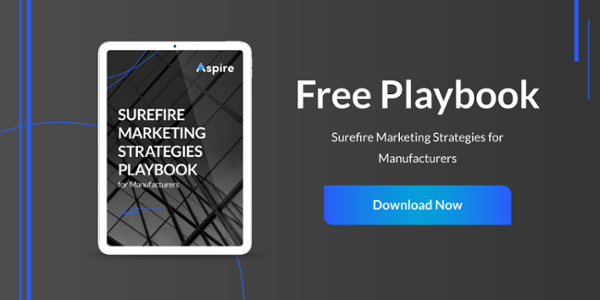- Inbound Marketing
- Manufacturing
- March 31, 2023
How to Drive Manufacturing Growth with Customer-Centric Marketing

Aaron Marks

B2B manufacturing has long relied on traditional sales and marketing approaches. These include networking, print ads, and trade shows. But the market is changing – and quickly. New buyers are entering decision-maker and leadership roles. Those buyers grew up on the internet and have totally different expectations. And as the COVID-19 pandemic put a damper on traditional marketing, these changes only accelerated.
To succeed in this new landscape, manufacturers must adjust their approach to marketing and acquiring customers. At its core, this involves adopting a customer-centric approach. By focusing on what marketers call the "buyer's journey," you can create resources that align with your audience's needs. This leads to stronger connections and better sales opportunities.
Understanding your audience's needs and preferences is vital. Adapting to new technologies and methods is also essential. In this blog post, we'll explore how to grow your manufacturing business by aligning your marketing strategy with customer needs.
By shifting to a customer-centric marketing approach, manufacturers can build better connections with their audience. This leads to growth and success in the modern marketplace. Read on to discover why now is the time to invest in customer-centric marketing strategies that resonate with your target audience.
The Importance of Understanding the Manufacturing Buyer's Journey
The manufacturing buyer's journey is complex, involving multiple decision-makers and stakeholders such as engineers, procurement officers, and company executives. Understanding the different perspectives and needs of each stakeholder is essential to developing a successful marketing strategy.
Identifying key touchpoints in the buyer's journey can lead to better targeting and improved engagement. By focusing on these critical touchpoints, you can tailor your marketing efforts to address specific concerns, questions, or challenges that your prospects may face. This targeted approach not only increases engagement but also fosters trust and credibility with your potential customers.
Understanding the buyer's journey also helps you create content that addresses specific pain points and drives conversions. When you have a deep understanding of your target audience's buyer's journey, you can develop resources that address their unique pain points and challenges.
The B2B Institute has found that any given time, 95% of your customers are not looking to buy. But many of those customers are researching solutions. And if you can earn trust early in this process, then you can greatly increase the likelihood they'll buy from you. Creating targeted content helps establish your company as a thought leader and a trusted resource, making prospects more likely to choose your products or services.
The Stages of the Manufacturing Buyer's Journey
The manufacturing buyer's journey can be broken down into three primary stages:
Awareness (Top of Funnel)
In the awareness stage, prospects realize they face a problem or have a specific need. They might not know the exact nature of the issue yet. Your marketing efforts should aim to create educational content that helps potential customers understand their challenges and how your products or services can help. For example, a manufacturer of industrial pumps could publish blog posts, eBooks, and videos about common issues in pump operation, maintenance, and efficiency.
Additionally, you could share content that addresses broader industry trends, such as regulatory changes or technological advancements, that might impact your target audience. By providing valuable insights and information, you position your company as a knowledgeable resource and build trust with your prospects. For instance, a manufacturer of energy-efficient lighting could create articles discussing the benefits of upgrading to LED technology and the potential cost savings for businesses.
Consideration (Middle of Funnel)
During the consideration stage, prospects have pinpointed their problem or need and are researching possible solutions. Your marketing should demonstrate the value and benefits of your products or services while addressing potential objections or concerns. For instance, a company that manufactures conveyor systems could create whitepapers and webinars to highlight their expertise and the advantages of their products.
In addition to showcasing the strengths of your offerings, it's essential to differentiate your brand from competitors. By sharing content that highlights your unique selling proposition (USP), you can make your products or services more attractive to potential customers. For example, a custom metal fabrication company could emphasize their expertise in working with exotic materials or their commitment to rapid turnaround times.
Decision (Bottom of Funnel)
In the decision stage, prospects are prepared to make a purchase but might still be evaluating different vendors or solutions. Your marketing should provide the information and support needed to help prospects make a confident decision. For example, a manufacturer of safety equipment could share testimonials, case studies, product demonstrations, and detailed product information that emphasizes the unique features and benefits of their offerings.
It's also crucial to address any remaining concerns or questions prospects may have at this stage. By providing thorough, transparent information and excellent customer support, you can make it easier for prospects to choose your company. For instance, a manufacturer of industrial automation solutions could offer comprehensive technical documentation and personalized consultations to help customers better understand their products' capabilities.
Mastering Multi-Channel Marketing for Manufacturers
To effectively reach and engage your target audience throughout the buyer's journey, it's essential to leverage a multi-channel marketing approach. This means using a combination of traditional and digital marketing channels to deliver a consistent and cohesive message to your prospects.
Inbound Marketing
Inbound marketing focuses on attracting prospects to your website and content by providing valuable, educational, and informative resources. This approach helps establish your brand as an industry expert and builds trust with your audience. Strategies to consider for inbound marketing include search engine optimization (SEO), content marketing, and social media marketing.
Outbound Marketing
Outbound marketing involves reaching out to potential customers through traditional channels like trade shows, events, and print ads. While these methods can still be effective, it's crucial to integrate them with digital marketing efforts to maximize their impact. For example, you can offer a lead magnet for download by iPad at your trade show booth, or include a QR code in print ads that directs prospects to a landing page where they can download valuable content.
For B2B manufacturers, outbound marketing methods like trade publications and events remain valuable channels for manufacturers to connect with their target audience. But there are opportunities to get more value out of them. Collaborating with trade organizations can help you reach a wider audience and position your company as a thought leader. Consider hosting webinars and contributing articles to these organizations to create content that resonates with your target market.
Account Based Marketing (ABM)
Account Based Marketing is a highly targeted approach that focuses on specific high-value accounts, allowing you to personalize your marketing efforts to address the unique needs and preferences of each account. By combining ABM with your inbound and outbound marketing strategies, you can create a more comprehensive marketing approach that drives faster ROI and revenue growth.
Conclusion: Seize the Competitive Edge by Focusing on the Buyer's Journey
Understanding the manufacturing buyer's journey is essential for developing a marketing strategy that resonates with your target audience and drives results. By recognizing the unique needs and challenges of your prospects at each stage of the buyer's journey, you can create content and marketing initiatives that engage and convert potential customers.
To achieve success in this competitive landscape, manufacturers must master multi-channel marketing, blending traditional channels like trade shows and publications with digital strategies such as inbound marketing, social media, and account-based marketing. By embracing a comprehensive approach that considers every touchpoint in the buyer's journey, your manufacturing business can build trust, credibility, and ultimately, drive sales.
In today's era, the key to a successful marketing strategy is understanding your customers' needs and aligning your efforts to address those needs throughout their buyer's journey. By doing so, you'll position your manufacturing company as a trusted resource and industry leader, setting the stage for long-term success and growth.
At Aspire, we specialize in helping B2B Manufacturers grow their business through effective marketing strategies. We offer a complimentary assessment to help identify areas of opportunity and create a tailored plan for your business. Contact us today to learn more about how we can help you reach your growth goals.
Aaron Marks is the Chief Marketing Officer of Execo. A digital pioneer with nearly two decades of online marketing experience, Aaron has helped organizations ranging from fledgling startups to Fortune 500 enterprises, and global manufacturers to U.S. Presidential campaigns, get the marketing and business results they needed.


0 Comments